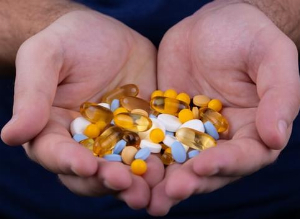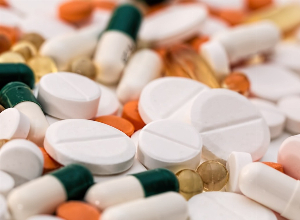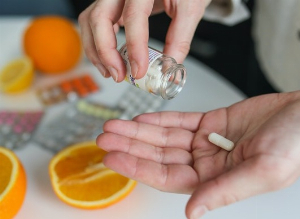Prescription Drug Addiction: What are the risks and how to quit?
Published 17 Aug 2020 • By Alexandre Moreau
Drug addiction is a psychological and sometimes physical condition that causes compulsive, continuous or periodic behavioural reactions. It affects around 3.2 million people across England and Wales and is linked to the consumption of various substances (mainly antianxiety drugs, hypnotics and analgesics). What is addiction? How does it work? Which drugs are most frequently involved? What are the risks of addiction and how can one avoid it?

Addiction and dependence: What's the difference?
Dependence is a psychological (an impulse to consume a drug in order to create pleasure or to relieve tension) and sometimes a physical state (the body's need to consume a drug in order to avoid a withdrawal syndrome) characterised by changes in behaviour that invariably include the compulsion to take a drug in order to experience its effects and sometimes to avoid the discomfort of withdrawal.
Addiction is characterised by dependence (repeated inability to control a behaviour) and the continuation of that behaviour despite knowledge of the negative consequences. Addictions can be varied: tobacco, alcohol, illicit substances, medication (with possible self-medication for over-the-counter drugs without a prescription), gambling, etc.
What are the mechanisms behind addiction?
The neurobiological mechanisms of addiction are strongly linked to the brain's "reward system". This circuit is responsible for the sensation of pleasure felt after basic actions (drinking, eating, having sex, etc.) and involves different networks of neurons (mainly dopaminergic neurons, but also serotonergic and noradrenergic). Endorphin receptors also play a role in analgesia (pain reduction) and the feeling of well-being.
Repeated drug use has a long-term effect on brain networks (called "synaptic plasticity", which corresponds to the modification of communication systems between neurons) and disrupts the pursuit of pleasure. An increased release of dopamine (the "pleasure and reward" molecule) is then observed and provokes an incessant need for pleasure. In addition, the natural production of endorphins is gradually diminished and pleasure is only obtained through the intake of the external substance (tolerance to this substance increases and a craving appears as soon as consumption is stopped).
Other cerebral changes end up creating a negative effect in the dependent subject (mood changes, anxiety, irritability). This negative emotional state, associated with the unpleasant sensations of withdrawal (deprivation of the addictive substance), then becomes the main motivation to use (as the subject experiences intense cravings, which corresponds to the compulsive need to use something), beyond the search for pleasant effects.
Finally, these mechanisms seem to alter the memory of the experience, to make it even more pleasant than it actually was, and persist over time, encouraging the user to repeat the experience.
What are the contributing factors to addiction?
Some individuals (especially males) have a genetic predisposition to develop addictions. The risk of addiction is greater if there is a family history of addiction or if there is a pre-existing use of other substances (alcohol, drugs or other medication). Psychological vulnerability (introversion, anxiety, depression, low self-esteem, difficulty solving problems, impulsivity, thrill-seeking, etc.) and the existence of physical (chronic illnesses) and psychiatric (bipolar disorder, eating disorders, attention deficit disorder, etc.) comorbidities can also lead to addictive behaviours.
Environmental factors also contribute to addictive behaviour, such as situations of major stress, a difficult social and family environment or easy access to the addictive substance (parents who smoke, suffer from psychiatric disorders, etc.). Finally, certain professions are more at risk of addiction (a medical environment, travelling with jet lag, night work, etc.).
Which drugs can lead to addiction?
Psychoactive drugs
Benzodiazepines (BZDs) can cause physical and psychological addiction. They include antianxiety drugs (or tranquillisers such as alprazolam-XANAX®, bromazepam-LEXOTAN® or diazepam-DIAZEMULS®, DIAZEPAM DESITIN®, STESOLID RECTAL TUBES®) which reduce anxiety and manifestations of anxiety (insomnia, muscle tension, etc.) and hypnotics/sedatives (or sleeping pills like zolpidem-STILNOCT® or zopiclone-ZIMOVANE®) which are intended to induce and/or maintain sleep.
On the other hand, it is interesting to note that first-line antidepressants (escitalopram-CIPRALEX®, fluoxetine-PROZAC®, paroxetine-SEROXAT®, sertraline-LUSTRAL® or duloxetine-CYMBALTA® et venlafaxine-EFEXOR XL®) are not addictive. However, it is essential to adhere to the prescription without sudden or early discontinuation to avoid the risk of relapse.
Analgesics (or painkillers)
Depending on the type of molecule, there is a possible risk of addiction. This applies to drugs for moderate to severe pain (opiates derived from opium or synthetic opioids):
- Codeine, an analgesic and antitussive (to prevent cough), can cause physical dependence and can be misused (it is often used in a cocktail called "Lean" or "Purple Drank" which induces euphoria and drowsiness). It comes alone in tablet form (codeine phosphate) or as a syrup (codeine linctus), but also mixed with paracetamol (Co-Codamol, CODIPAR®, SOLPADEINE PLUS®, SOLPADOL®).
- Dihydrocodeine (DHC CONTINUS®), derived from codeine, may also be prescribed and be addictive.
- Tramadol alone (MANEO®, MAXITRAM®, TILODOL®) or in combination with paracetamol (TRAMACET®) also carries the risk of dependence if used in high doses over a long period of time.
- Morphine (MST®, ZOMORPH®, SEVREDOL®, MORPHGESIC®, MXL®) is used in situations where less potent analgesics are insufficient.
- Fentanyl (DUROGESIC®, ACTIQ®, MATRIFEN®, FENCINO®, FENTALIS®,) is 100 times more potent than morphine and is used only for severe and unrelenting pain, and for short periods of time. Like many opioids, fentanyl can be misused for recreational purposes.
Among non-morphinic analgesics, nefopam (ACUPAN®) acts centrally and is authorised for acute pain, particularly post-operative pain. It also exposes the patient to a risk of dependency.
Finally, it should be noted that the frequent abuse of analgesics (paracetamol-DISPROL®, HEDEX®, PANADOL®) in patients suffering from headaches contributes to the chronisation (permanence) of headaches.
Other potentially addictive drugs
Stimulants such as caffeine and nicotine have addictive properties. This effect is even more pronounced for amphetamines and its derivatives:
- Pseudoephedrine used in nasal decongestants such as SUDAFED®, BENADRYL®, BENYLIN®, MULTI-ACTION ACTIFED® or GALPSEUD PLUS LINCTUS®
- Methylphenidate-RITALIN® used for attention deficit hyperactivity disorder (ADHD)
- Modafinil-PROVIGIL® used in patients with narcolepsy or hypersomnia
In addition, anaesthetics (medical gases such as oxygen or nitrous oxide), anti-migraine drugs (which can be mixed with caffeine or painkillers), sedative anti-histamines (if taken frequently, such as hydroxyzine-ATARAX® or alimemazine) or anti-Parkinson's drugs (trihexyphenidyl-ARTANE®) have a mental addictive potential that should not be overlooked.
Finally, although they do not contain addictive substances per se, laxatives (like bisacodyl-DULCOLAX®) can cause physical dependence when used frequently or continuously (for more than 10 days). There is a risk of becoming dependent and mucosal irritation may lead to increased constipation when the drug is no longer taken.
How can addiction be prevented?
To avoid dependency, it is necessary to follow the dosage and usage instructions recommended by the doctor.
When using psychotropic drugs (benzodiazepines):
- Sleeping pills should not be taken regularly over a long period of time because there is a risk of dependence and addiction with escalation of dosage (increase in dose);
- Anxiolytics should be gradually increased in dose to reach the minimum effective dose to limit adverse effects and the risk of dependence.
There is a maximum duration of prescription (4 weeks for hypnotics and 12 weeks for anxiolytics) then a re-evaluation must be done by the doctor. Treatment should be discontinued by gradually reducing the dose. Consumption of alcohol while taking these medications is dangerous.
For the treatment of chronic pain, analgesics (painkillers) should be taken at regular intervals (this is more effective than taking them on demand).
In other cases, painkillers should not be used for more than 5 days without a doctor's approval. And in the case of non-cancerous pain, the use of morphine should be as short as possible, in order to avoid possible dependence.
Finally, to avoid addiction to laxatives and aggravation of constipation, a gradual decrease in dosage over several weeks is recommended. It is also possible to replace them with non-irritating laxatives (called osmotic laxatives, such as, MOVICOL®, or DUPHALAC®). A high-fibre, low-fat diet, plenty of water and regular physical activity are also recommended.
What risks does an addiction pose?
Regular consumption of a substance can cause the body to adapt itself. Such adaptation results in a progressive decrease in the activity of the substance (less and less pronounced effects) which leads to an increase in dosage to achieve the same effects (known as tolerance). This then exposes the body to the risk of overdose, which is potentially fatal (especially if multiple substances are consumed, i.e. alcohol, other medicines, etc.).
When attempting to taper off the drug, a substance-specific withdrawal syndrome may be observed, which may include:
- Benzodiazepine withdrawal, which causes rebound of anxiety, insomnia, even epileptic seizures consisting of very dangerous convulsions;
- Withdrawal from morphinic drugs, which leads to widespread pain, diarrhoea and a state of psychological and physical stress (anxiety, insomnia, sweating, hot or cold flashes, runny nose, palpitations, rise in blood pressure, etc.).
More specifically, some medicines can affect professional performance (attention disorders, memory disorders, difficulties in communication). They can also have an impact on driving, with an increased risk of accidents (this is particularly the case with psychotropic drugs).
Finally, the progressive loss of self-control and the resulting addiction can have lasting and significant social consequences: isolation, marginalisation, dropping out of school, loss of employment, deterioration of relations with family and friends, financial problems, etc.
How should treatment for addiction be carried out?
Treatment for addiction and detoxification should be initiated under medical supervision by one's GP. He or she may also call in an addiction specialist or psychiatrist.
Detox should be gradual and ideally take place at a favourable time (i.e. not during a stressful period such as bereavement, an examination or moving house, and give preference to quieter times such as the holidays).
Doses should be reduced in stages to avoid withdrawal symptoms (convulsions, insomnia, anxiety). The closer one gets to the end of withdrawal, the longer the stages should be. And if there are signs of withdrawal, it is important to tell one's doctor in order to decide with him/her to go back to the previous stage or to slow down the withdrawal.
Medication to reduce the risk of withdrawal complications may be suggested (e.g., non-addictive antidepressants for anxiety, panic attacks and phobic disorders, or melatonin for insomnia).
Psychological support, relaxation, therapy and stress management are also recommended during withdrawal.
Finally, long-term support by health professionals (such as the GP and pharmacist) and family and friends helps prevent the risk of relapse.
Was this article helpful to you?
Feel free to share your thoughts with community in the comments below and ask any question you may have!
Take care!
https://www.inserm.fr/information-en-sante/dossiers-information/addictions
https://www.addictaide.fr/medicaments/questions-frequentes/
https://www.drogues.gouv.fr/comprendre/les-produits/medicaments-psychoactifs
https://www.ofdt.fr/produits-et-addictions/de-z/medicaments-psychotropes/
http://www-sante.ujf-grenoble.fr/SANTE/cms/sites/medatice/home/addictologie/docs/20110228122308/Addictions_aux_Medicaments_M.Dematteis.pdf
https://www.france-assos-sante.org/2015/12/16/addiction-medicamenteuse-suis-je-concerne
https://www.ameli.fr/assure/sante/themes/addictions/medicaments-usage-detourne-dependance
https://www.frcneurodon.org/comprendre-le-cerveau/le-cerveau-malade-et-ses-maladies-neurologiques/les-addictions/
https://www.addictaide.fr/comprendre-les-mecanismes-neurobiologiques/
1 comment


 Facebook
Facebook Twitter
Twitter


